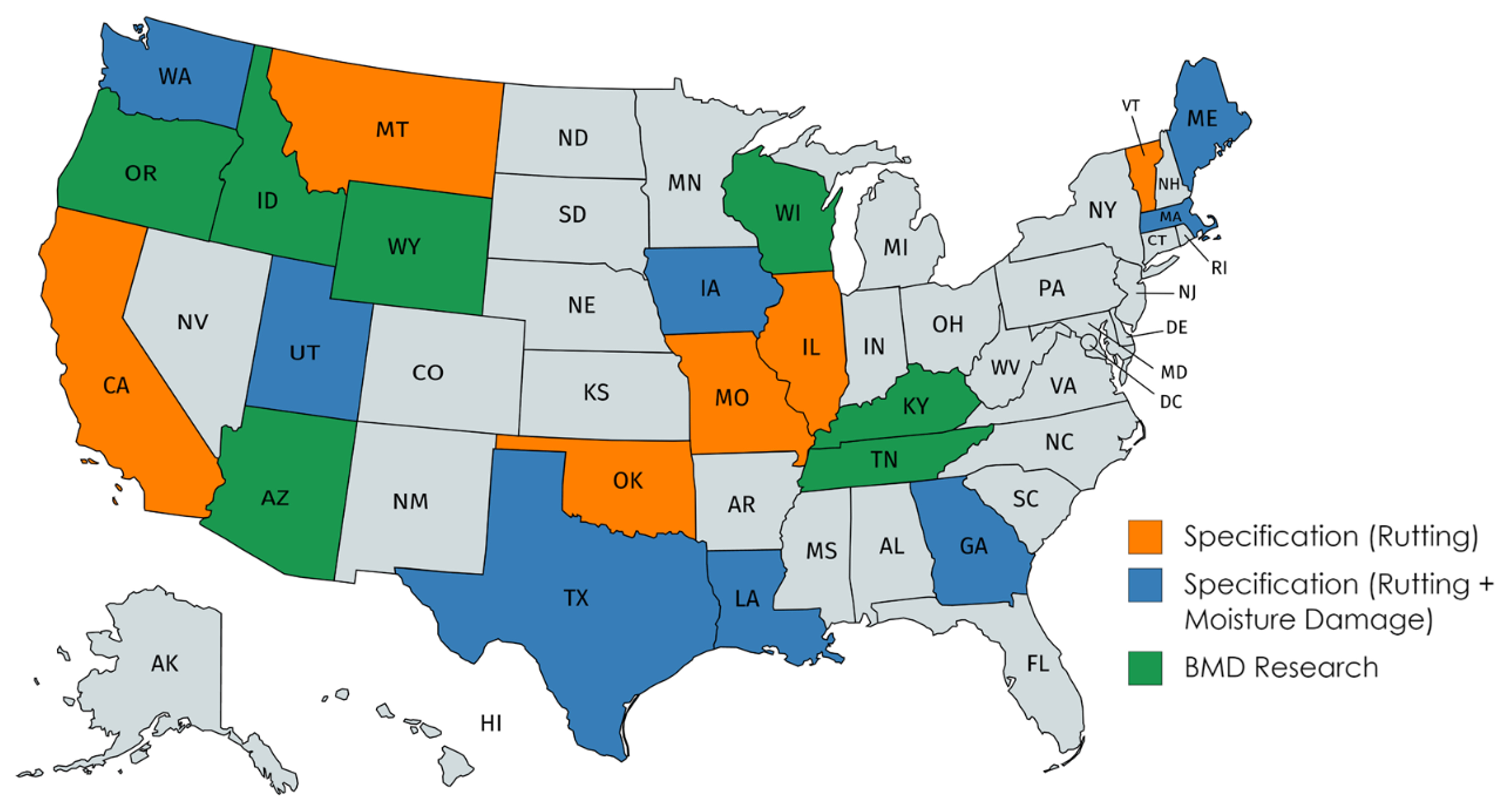- Fall 2020
Using the Hamburg Wheel Track Test for Balanced Mix Design
The Hamburg Wheel Tracking Test (HWTT) per AASHTO T 324 is widely used by asphalt researchers and pavement engineers to evaluate the rutting resistance and moisture susceptibility of asphalt mixtures. According to a recent NCAT survey of state highway agencies and the asphalt pavement industry, 14 states currently require the HWTT in their provisional or standard specifications for asphalt mix design. Among these states, six use the HWTT as a pure rutting test while the rest use it as a combined rutting and moisture damage test. Additionally, there are seven states that have selected the HWTT as a performance test for balanced mix design (BMD) and are currently conducting research to benchmark existing mix designs or develop preliminary performance criteria for BMD pilot or shadow projects.

Use of Hamburg Wheel Track Test by State Highway Agencies in the U.S.
A typical HWTT rut depth curve consists of a post-compaction phase, a creep phase, and sometimes a stripping phase. Traditional HWTT parameters include total rut depth (TRD) at a certain number of wheel passes, creep slope (CS), stripping slope (SS), and stripping inflection point (SIP). There is a consensus among the existing literature that TRD and CS are often used to evaluate the rutting resistance of asphalt mixtures, while SS and SIP are mainly used for the assessment of moisture susceptibility.
Over the years, asphalt researchers have proposed alternative HWTT parameters to improve characterization of the rutting and moisture resistance of asphalt mixtures. These alternative parameters include the corrected rut depth (CRD), rutting resistance index (RRI), and stripping number (SN). CRD represents the projected HWTT rut depth caused only by permanent deformation of the mixture, which is isolated from the rut depth due to the stripping of asphalt binder from the aggregates. RRI is calculated based on the rut depth and number of wheel passes at completion of the test, which allows the direct comparison of HWTT results with different test termination points. A normalized RRI (NRRI) can also be used to account for different criteria dependent on binder grade. SN, developed as an alternative moisture susceptibility parameter to SIP , is defined as the inflection point of the HWTT curve fitted with a three-parameter deformation model. It represents the maximum number of wheel passes that the mixture can resist in the HWTT before stripping occurs.
Although most of the traditional and alternative parameters can identify asphalt mixtures that are extremely susceptible to rutting and/or moisture-related distresses, little information is available as to how they correlate to actual pavement field performance. In recognition of this limitation, researchers at NCAT and the Texas A&M Transportation Institute (TTI) collaborated on a study where they compiled a HWTT database with test results of over 70 plant-produced mixtures. These mixtures were collected from 17 field projects evaluated in several NCHRP projects, an LTPP test section, and test sections on the NCAT Test Track. HWTT testing was conducted at NCAT and TTI laboratories over the last 10 years. The database was then analyzed to determine the correlation of various HWTT parameters to field performance data and estimate the within-laboratory repeatability of HWTT rut depth measurements.
The correlation evaluation of HWTT rutting parameters was conducted using 17 mixtures from the NCAT Test Track. The analysis results indicated that the RRI and CS parameters showed the best correlation to pavement rut depth measured after 10 million ESALs of heavy truck traffic (R 2 = 0.924 and 0.881, respectively), followed by CRD (R 2 = 0.586) and then TRD at 20,000 passes (R 2 = 0.283). The field correlation of HWTT moisture susceptibility parameters was evaluated based on a receiver operating characteristic (ROC) analysis, using all mixtures in the database. The ROC analysis, simply described, assesses the degree of correspondence between the HWTT results and field performance that is qualitatively categorized as either ‘with moisture distress’ or ‘without moisture distress’. The ROC analysis identified 9,000 and 2,000 passes as the best criterion for SIP and SN, respectively. However, these criteria should be used with caution because they were developed with a limited number of mixtures with signs of moisture damage in the field and thus, warrant further verification with additional laboratory and field data. Finally, the within-laboratory repeatability of HWTT rut depth measurements was determined largely in accordance with ASTM C670. The maximum allowable differences in rut depth measurements between two HWTT replicates (e.g., results of the left wheel versus right wheel from the same run, or results of the same wheel from two separate runs) were calculated to be 2.3, 3.9, 4.6, and 4.7 mm for TRD at 5,000, 10,000, 15,000, and 20,000 wheel passes, respectively. Therefore, it is recommended that the two sets of HWTT replicate results with a difference greater than these allowable differences should not be accepted.
In addition to these research findings of the NCAT/TTI study, another recommendation for consideration by states interested in adopting HWTT for BMD is to use a standardized data analysis program (or software) for mix design approval and/or production acceptance. To ensure consistency between the contractor and agency results, specific instructions should be provided regarding the number and locations of deformation readings (along the track length) used for data analysis and the calculation of selected test parameters, among others.
A good example for reference is provided by the Iowa Department of Transportation in Matls IM 319 at iowadot.gov/erl/current/IM/content/319.htm.
|
Details about the development of alternative HWTT parameters can be found in the following issues of Transportation Research Record: Journal of the Transportation Research Board. Yin, F., E. Arambula, R. Lytton, A. E. Martin, and L. G. Cucalon. Novel Method for Moisture Susceptibility and Rutting Evaluation Using Hamburg Wheel Tracking Test. No. 2446, 2014, pp. 1-7. Wen, H. F., S. H. Wu, L. N. Mohammad, W. G. Zhang, S. H. Shen, and A. Faheem. Long-Term Field Rutting and Moisture Susceptibility Performance of Warm Mix Asphalt Pavement. No. 2575, 2016, pp. 103-112. Yin, F., C. Chen, R. West, A. E. Martin, and E. Arambula-Mercado. Determining the Relationship Among Hamburg Wheel-Tracking Test Parameters and Correlation to Field Performance of Asphalt Pavements. No. 2674(4), 2020, pp. 281-291. |

For more information about this article, please contact Fan Yin.